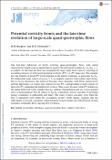Potential vorticity fronts and the late-time evolution of large-scale quasi-geostrophic flows
Abstract
The late-time behaviour of freely evolving quasi-geostrophic flows with initial characteristic length scale L0 larger than or equal to the deformation radius LD, L0/LD≥1 , is studied. At late time the flows are dominated by large multi-level vortices consisting of ascending terraces of well-mixed potential vorticity (PV), i.e. PV staircases. We examine how the number of mixed PV levels depends on the initial conditions, in particular L0/LD . For sufficiently large values of L0/LD≈5 , a complete staircase with regular steps forms, but as L0/LD decreases, the staircase becomes more irregular, with fewer mixed levels and the appearance of a large step centred on zero PV, corresponding to large regions of near-zero PV separating the multi-level vortices. This occurs because weak PV features in the initial field with scales smaller than LD undergo filamentation and are coarse-grained away or homogenised. For all values of L0/LD considered, inverse cascades of potential energy commence at sufficiently late times. The onset of these cascades, even when the flow is initialised well within the ‘asymptotic model’ (AM) regime, suggests that the AM regime is not self-consistent: when potential vorticity fronts are well-resolved, frontal dynamics eventually drive ongoing flow evolution.
Citation
Burgess , B H & Dritschel , D G 2022 , ' Potential vorticity fronts and the late-time evolution of large-scale quasi-geostrophic flows ' , Journal of Fluid Mechanics , vol. 939 , A40 . https://doi.org/10.1017/jfm.2022.194
Publication
Journal of Fluid Mechanics
Status
Peer reviewed
ISSN
0022-1120Type
Journal article
Description
Funding: BHB acknowledges support for this research from a Leverhulme Trust Early Career Fellowship.Collections
Items in the St Andrews Research Repository are protected by copyright, with all rights reserved, unless otherwise indicated.

